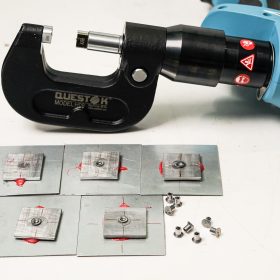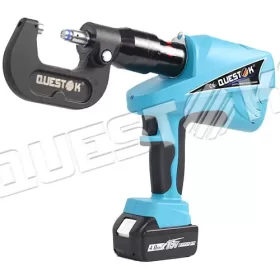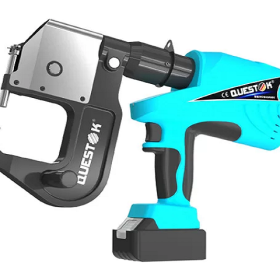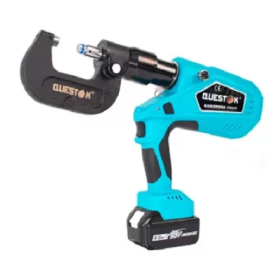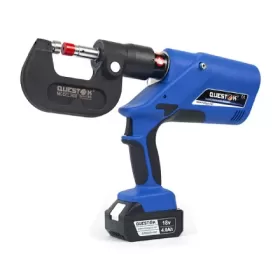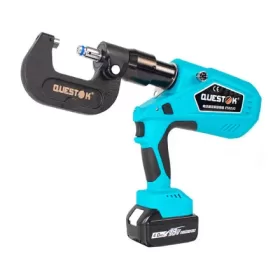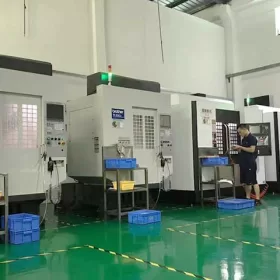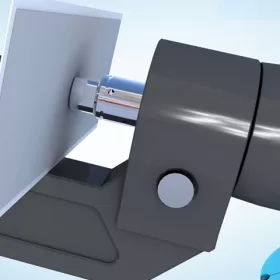Comparing Rivetless Clinching Guns and Traditional Riveting Methods
In the realm of industrial fastening, the choice between rivetless clinching guns and traditional riveting methods often arises. Both techniques offer distinct advantages and drawbacks, making it imperative to understand their key differences to make informed decisions.
Process and Machinery
Rivetless Clinching:
– Involves pressing two metal sheets together using a clinching tool.
– No rivets are used; instead, the tool creates an interlocking joint by displacing the material at the overlap.
Traditional Riveting:
– Requires a specialized rivet gun to insert and drive a rivet through pre-drilled holes in the metal sheets.
– The rivet head is then formed on the opposite side of the sheets.
Joint Strength and Integrity
Rivetless Clinching:
– Creates strong, gas-tight joints that can withstand high loads.
– Eliminates the need for rivets, reducing the risk of fatigue failure.
Traditional Riveting:
– Provides high joint strength but requires a larger hole diameter.
– Rivets can be vulnerable to fatigue and stress cracking, potentially compromising joint durability.
Material Compatibility
Rivetless Clinching:
– Compatible with various metals, including aluminum, stainless steel, and galvanized steel.
– Can join sheets of different thicknesses and material combinations.
Traditional Riveting:
– Also compatible with a range of metals, but limited by the hole diameter and rivet size.
– May require specialized rivets for different materials or joint configurations.
Cost and Efficiency
Rivetless Clinching:
– Typically more expensive than traditional riveting due to the specialized equipment.
– However, it eliminates the cost of rivets and offers faster processing times.
Traditional Riveting:
– Lower initial investment costs compared to clinching guns.
– Requires additional time and materials for drilling and rivet installation.
Maintenance and Longevity
Rivetless Clinching:
– Requires periodic tool maintenance to ensure proper alignment and clinch force.
– Generally has a longer lifespan than riveting machines.
Traditional Riveting:
– Requires frequent replacement of rivets and occasional tool servicing.
– Regular maintenance is essential to prevent tool malfunctions and ensure consistent joint quality.
Conclusion
The choice between rivetless clinching guns and traditional riveting methods depends on specific application requirements. For high-strength, gas-tight joints in a wide range of materials, rivetless clinching offers advantages in speed, durability, and joint integrity. Traditional riveting remains a viable option for lower-cost applications where multiple holes can be tolerated and rivet availability is not an issue. Ultimately, the best decision is tailored to the project’s unique requirements and constraints.
- Company News
- Industry News
- Tag
- Tags
-
The Advantages of Questok Rivet Guns: Precision, Efficiency, and Durability
In industrial fastening applications, the choice of tools directly impacts productivity, safety, and long-term cost-effectiveness. Questok rivet guns have emerged as a standout solution for professionals across aerospace, automotive, and construction sectors. Combining advanced engineering with user-centric design, these tools deliver unmatched performance. Below are the key advantages that make Questok rivet guns a preferred choice:
-
Rivet Gun FAQ
Rivet Gun FAQ-SPR
-
Fast Assembly and Repair With Cordless Solid Rivet Gun
Questok cordless solid rivet gun stands out as a pivotal innovation, merging portability with power to facilitate efficient and effective fastening in a myriad of applications.
-
Redifine The Role of Self-piercing Riveting Gun Machine
Self-piercing riveting adopts high-speed mechanical fastening skill that joins thin sheet materials, typically steel and aluminum alloys.
-
The Latest Innovations in Clinching Tool Design
Explore the latest innovations in clinching tool design, redefining precision, efficiency, and versatility in material joining.
-
The Application and Maintenance of Self-Piercing Rivet Guns
Delve into the applications of self-piercing rivet guns in the automotive and aerospace industries and reveal the essential maintenance practices that ensure their accuracy and efficiency.
-
Rivetless Riveting Gun for Ventilation Duct Projects
The ventilation duct rivetless gun is a tool for riveting ventilation ducts without rivets.
-
Guide to Using Self-Piercing SPR Riveting Gun
In the automotive industry, self-piercing SPR (Self-Piercing Rivet) riveting guns are commonly used for joining metal components in vehicle bodies, including BMW vehicles.
-
Rivet Gun FAQ
Rivet Gun FAQ-SPR
-
User-Friendly Features- Making Riveting Easy with Electric Blind Rivet Guns
Electric blind rivet guns are essential tools for industrial applications, providing a convenient and efficient way to fasten materials together. These tools have significantly advanced, incorporating user-friendly features that enhance their functionality and ease of operation. This article explores several key user-friendly features of electric blind rivet guns, highlighting how they simplify and streamline the […]
-
Unleashing Potential- Unlocking the Versatility of a Handheld Rivet Gun
In the realm of construction and fabrication, precision and efficiency reign supreme. Among the indispensable tools that empower craftsmen and DIY enthusiasts alike, the handheld rivet gun stands as a beacon of versatility and innovation. This unassuming device harbors a hidden potential that belies its compact form, offering a plethora of applications that unlock unbounded […]
-
Versatile Fastening- Applications of the Handheld Rivet Gun Across Industries
In the realm of fastening, the handheld rivet gun stands as a testament to ingenuity and versatility. Its ability to effortlessly join materials with sheer strength and permanence has revolutionized manufacturing and construction processes, leaving an enduring mark on diverse industries. Aerospace: Where precision and reliability are paramount, the rivet gun shines. In aircraft assembly, […]
-
The Role of Automation in Electric Rivetless Clinching
Electric rivetless clinching (ERC) is a lightweight joining process that eliminates the need for rivets or other fasteners. This can lead to significant cost savings and increased production efficiency. Automation plays a critical role in ERC, enabling high-speed and high-volume production. Automated Feed Systems Automated feed systems are used to accurately position the two workpieces […]
-
Why Choose a Universal Self-Piercing Riveting Gun for Your Projects?
In the realm of construction and fabrication, riveting guns stand as indispensable tools for creating secure and robust connections. Among the various types available, universal self-piercing riveting (SPR) guns have emerged as a game-changer due to their versatility and efficiency. This article will delve into the compelling reasons why choosing a universal self-piercing riveting gun […]
-
Why Choose Stainless Steel Hollow Rivets for Your Projects?
In the world of industrial manufacturing, choosing the right fasteners for your projects is crucial for ensuring longevity and reliability. Among the many options available, stainless steel hollow rivets stand out as a superior choice for a wide range of applications. This article delves into the compelling reasons why stainless steel hollow rivets are the […]
-
Top Trends in Electric Rivetless Clinching Guns
In the realm of fastening technology, electric rivetless clinching guns have emerged as a revolutionary solution for a wide range of industrial applications. These advanced tools offer several преимущества and capabilities, revolutionizing the way businesses approach their fastening needs. Adoption of Brushless Motors Brushless motors have gained significant traction in electric rivetless clinching guns due […]
